Trader’s diary (aka trader’s journal) is unarguably the most important tool for every trader who wants to prosper. This is a common electronic notebook where you can add links and screenshots in addition to the standard text messages. MaxProfit trader’s diary is one of the best tools for deep understanding of how your own trading looks like.
Why does a trader need a diary? If you continue to lose money in the market, you undoubtedly need to take care of keeping a trader’s diary. Any professional trader can confirm that. When you record your every move in the diary you will not only remember your emotions and conditions as time passes but also will you see your progress. The retrospective look gives you a clear picture of your past mistakes and understanding what you could have done better — did you follow your trading plan; did you have a chance to make a better exit? It is important to remember that you keep trader’s diary for yourself.
You should start keeping your trader’s diary from the very first days of your trading experiments even before you’ve opened your first account. It would be useful to start learning how to trade with the help of MaxProfit strategy tester as any intuition comes along with the solid experience and it is preferable to have enough expertise before you put your money at risk. If you really have a plan to succeed in the financial market, you must constantly record your achievements and misfortunes and trader’s diary is your first helper and it should become the obligatory instrument for all your actions.
In the capital markets, mistakes are always part of the game. When you identify your mistake, it is necessary to write a short review and add screenshots and links to it because it will teach you how to avoid this mistake in the future. You should check your trader’s diary and recall any time you’re uncertain why did you make these moves and why you stopped at some point of your trading. When you close your trade and you haven't looked at it for a while, your live emotions of being right or wrong about your trade will no longer exist in case they are not written down. But if they are written down, you will know for sure what you can learn from that trade and know what to improve next time.
It is vital to track your physical conditions before, during and after the trade, you must notice if you were agitated or calm, anxious or tranquil, find the objectives led to successful and failed past trades and as a result, you will get a detailed picture of your trading process.
When you plan your trading or observe what’s happened during and after the trade, you should attach your own labels, for example verify the source of the trade idea or specify exit method you used, which strategy you used etc. This will enable you to see whether you're most profitable when you trade on the long or short side, when trade stocks, or futures, etc. You always need to have a plan for your upcoming trading activities, both entry and exit rules, your actions in case your trade goes the right way or not, set up an exact number of trades per day or per months, level of reasonable risk you can afford and indicators in use.
When you add a new entry to your trading journal it is extremely important to add as much information as you can to identify what was the cause of this mistake if your trade was unprofitable. You should keep all your remarks of current market conditions, if it goes up or down or resides in indefinite conditions. It is necessary to analyze your performance regularly — on a weekly and a monthly basis, calculate the number of successful and unsuccessful trades, find out which instrument was the most profitable, what time frames and expiration dates give the best results.
By adding as much information as you can you’ll be able to prepare the significant base for trading analysis module for an in-depth analysis of your past activities and a road map for the upcoming successful trading.
Many traders are always skeptical about the idea of keeping such records as they say they can remember everything perfectly and recording of such kind of staff is just a waste of time. But why they keep losing their deposits repeatedly and couldn’t identify what was the cause of their problems?
Sooner or later all traders, without exception, come to an understanding that in order to improve the efficiency of exchange trading you need to keep a trader's log. Why is it important? Because it is this tool that turns a beginner into a professional. You probably know the situation when you trade continuous and can't see any results. There can also be profitable transactions from time to time, that may even help you go into black (but more often it's a negative experience), but it is merely the first stage in the development of trading skills.
There is a certain algorithm, by which, in principle, every sphere of life develops: you take an action, then analyze it, and you make corrections. The result is an improvement in this sphere of life because you will not repeat the action, which gave a negative result for you (or you'll take that action in a different way, taking into account the previously gained undesirable experience).
When you keep the trader's log in a disciplined manner and record all commercial transactions, you have a chance to analyze them and make priceless conclusions about your trading strategy and the tools that work or don't work. In fact, the analysis demonstrates your strengths and weaknesses in figures. What do you do next? Correct further actions considering the statistical information received! Namely, develop strengths and avoid weaknesses.
Let's consider a few examples. Let's say you have been keeping a trader's log for a couple of months now and noticed that most of your unprofitable transactions took place on Friday. What can you do with this information? As an experiment, try not to trade on this day of the week at all. A month later, according to this correction, it is revealed that trading results have improved by 10%.
Another example, on the basis of statistics filled you saw that if the transaction was closed in first 15 minutes since the trading day started, it yielded a loss with a likelihood of 90%. What's to be done? Make a rule: do not open a transaction in first 15 minutes since the opening of the new trading session.
Or this example - you have been filling the trader's log for three consecutive months and concluded that the most profitable transactions you made were when trading by figures: Head and shoulders, Triangle and Double top. For the rest of the figures, all in all, you have yielded a loss. This fact gave another opportunity to experiment: you decided to trade only those figures that bring you profit. This does not mean that other figures are always unprofitable. Maybe, you have not fully learned how to recognize them correctly and to trade on them. A couple of months have passed, and with the introduction of this rule, trading results improved by 19%.
The same goes for unprofitable transactions, without understanding why transactions bring you losses there is no way to eradicate these causes. The more transactions you record in the trader's log, the more you develop like a Pro, the more trading experience you accumulate, and the more accurate statistics you begin to see.
Generally, transaction log should contain all the basic information on the transaction. It is important that you understand the reason for which the position was opened, you need to see the conditions that prevailed at that moment, and, of course, the exact parameters of the transaction are important. Items that should be contained in the statistics log for each individual transaction are listed below.
The easiest way to display trading analysis is an Excel program. It is by means of this program beginners first try to fill out a trader's log. But how effective is it? The fact is that by filling statistics by means of Excel, a beginner due to lack of experience, spends a huge amount of time just to create this document.
Half gets stuck at this stage and virtually falls out of the race, But those few who remain face new difficulties - which additional options to add to see the full statistical picture (and most importantly, how to construct these tables to extract the necessary information). All-in-all, it is quite hard for a beginner to create a good trader's log on his own. It's much easier to use the ready-made solution.
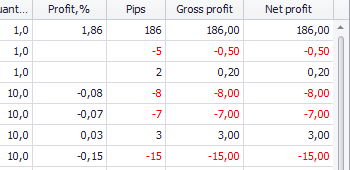
Diario de Trading - visually it looks a lot like MS Excel. In the same way, you can add lines and columns, group and filter the data, paint slots and lines, calculate totals, and more. The trading journal allows you to import data from all major trading platforms (Atas, cTrader, MT4, MT5, NinjaTrader7, NinjaTrader8), add an unlimited number of characteristics to each transaction and customize data presentation with various analytical instruments. Learn more about the Transaction log by following this link
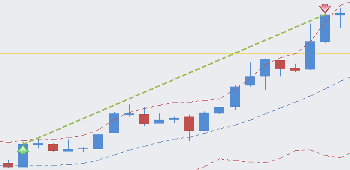
Probador de Estrategias - is a unique tool for manual testing of any strategy with the help of about 80 indicators. You can use the databases of all currencies traded for the past 8 years and 7500 stocks and futures, as well as your own data. Learn more about the Strategy Tester by following this link
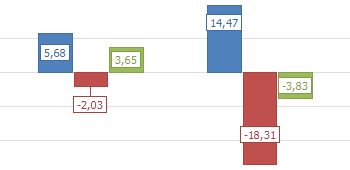
Análisis de Trading - is a powerful tool for deep analysis of the trade, Contains 92 markers, 260 diagrams, and graphs + user reports on transaction properties. Learn more about the Trading Analysis by following this link
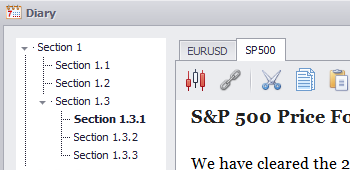
Diario del Trader - is a common electronic notebook. In addition to the standard resources for text layout, you can add screenshots and links to Transactions and Trades. Learn more about it by following this link
Let's go back to the Trader’s diary and see how to work with it.
There are 2 ways to do that:
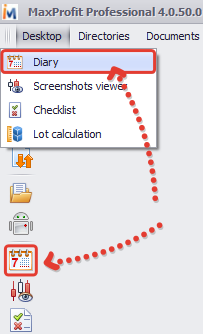
Work with the Trader’s diary starts with adding pages. The figure above shows 2 pages: SP500 and EURUSD. Let's add a new page 'Week plan'. It is assumed that before the start of a new workweek we will analyze various tools and make notes for the upcoming week.
To add a new page click the right mouse button in the pages area and select "Add" item from the context menu
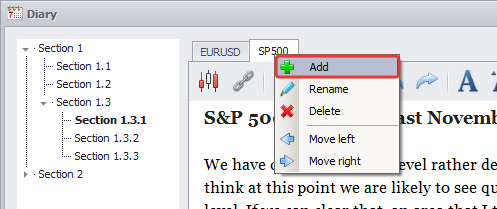
Type a new page name and click 'Save and close' button

After that, the form will look like as follow

To add a new section click the right mouse button in the left area and select "Add" item from the context menu
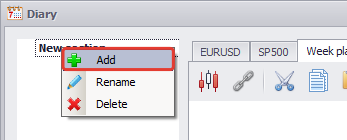
Type a new section name and click 'Enter'

As you can see working with a diary is very easy and simple.